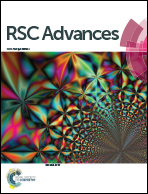Molecular stacking structure and field-effect transistor characteristics of crystalline poly(3-hexylthiophene)-block-syndiotactic polypropylene through solvent selectivity†
Abstract
We investigate the molecular packing structures, morphologies and field-effect characteristics of the crystalline–crystalline poly(3-hexylthiophene)-block-syndiotactic polypropylene block copolymers (P3HT-b-sPP) using different solvent mixtures of chloroform–cyclohexane (CF–CH). For the P3HT-b-sPP with a shorter sPP segment length, the increase of CH solvent content led to the P3HT domain with highly crystalline nanofibrillar networks and thus improved the charge transporting characteristics. For the P3HT-b-sPPs with a longer sPP segment length, well-defined microstructure and device characteristics were only observed at the 70 vol% CF content. Furthermore, the self-encapsulation of the insulating sPP blocks effectively improved the air stability of the P3HT-b-sPP field transistor devices. This work highlights the significance of solvent selectivity and rod/coil block ratios on the molecular packing and the organic field-effect transistor performances.


 Please wait while we load your content...
Please wait while we load your content...